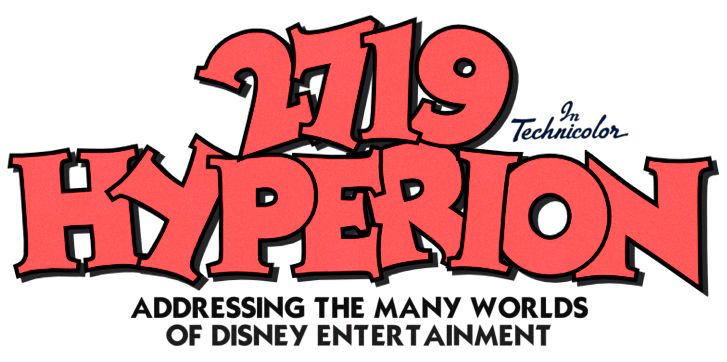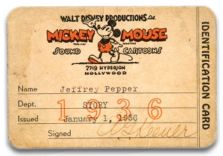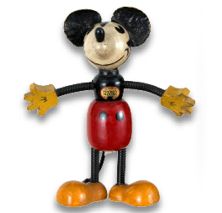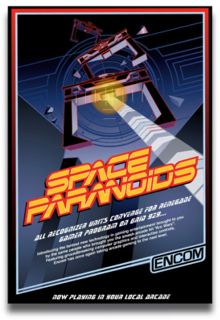 As an always important but still subtle presence in comic book stories featuring the madcap but well-intentioned Gyro Gearloose, the Little Helper literally shines as both a loyal companion and resourceful assistant to the eccentric and often absent-minded inventor. So intentionally nondescript in nature was this character that it never was given a name in any official capacity. In its lifetime of just over five decades, it has been alternately referred to as Helper, Little Helper, Gyro's Helper and Little Bulb.
As an always important but still subtle presence in comic book stories featuring the madcap but well-intentioned Gyro Gearloose, the Little Helper literally shines as both a loyal companion and resourceful assistant to the eccentric and often absent-minded inventor. So intentionally nondescript in nature was this character that it never was given a name in any official capacity. In its lifetime of just over five decades, it has been alternately referred to as Helper, Little Helper, Gyro's Helper and Little Bulb.The little micro-robot sprang from the pencil of legendary comics creator Carl Barks in 1956. Introduced as a pint-sized sidekick to Gyro Gearloose in the story The Cat Box, Barks provided no explanation or background for the character. It was a simple comic device that acted as the inventor's common sense counterpart. In a 1991 article, Barks scholar Geoffrey Blum shed light on Little Helper's origins:
No sooner had Barks created a Four-page slot for Gyro stories at the back of his Uncle Scrooge comic, than he began to realize how empty the panels were. "I invented the little lightbulb character one time to take the bareness out of the Gyro stories," he explained, "It looked a little thin, just one character sitting there, talking to himself all the time." Barks attacked the problem graphically, filling in the background with sight gags involving a little wire man, but his language suggests that he was filling an emotional hole, providing a distraction for Gyro as much as for the reader. The inventor needed a companion.
 As Barks' Gyro Gearloose stories evolved, Little Helper became a surprisingly well-defined supporting character with a very distinct and engaging personality. Often, its comic vignettes ran parallel to Gyro's panel by panel actions; it was particularly adept at interacting with small animals, often using the creatures for sport and amusement, though never in a mean-spirited nor malicious manner. And in some ways, Little Helper became much, much more. As Blum further noted:
As Barks' Gyro Gearloose stories evolved, Little Helper became a surprisingly well-defined supporting character with a very distinct and engaging personality. Often, its comic vignettes ran parallel to Gyro's panel by panel actions; it was particularly adept at interacting with small animals, often using the creatures for sport and amusement, though never in a mean-spirited nor malicious manner. And in some ways, Little Helper became much, much more. As Blum further noted:With this naming, the bulb acquires a new role, that of rescuer. He is still mischievous, but now the mischief is incidental, and plots turn increasingly on his ability to assist his master. Gyro remains the hero of the four-page parables, and Barks' message remains the same: man is incapable of total control, and the greatest attempt to master life often leads to the greatest disaster? But now a moral slips in: steady effort, however small, can succeed where grandiose plans have failed. Cynical comments on man's fallibility give way to covert lessons in love, and the little wire man is increasingly depicted being emotionally attached to Gyro. The perfect companion, it seems, is one who pursues an independent course (or plotline) but is there when you need him. Loneliness, attractive and necessary as it may be to the creative artist, is in its own way an attempt at mastery. Don't benefit the world by dominating it with your brain; give by helping in small ways.
 To celebrate the 50th Anniversary of the first appearance of Gyro Gearloose, modern four color duck scribe Don Rosa in 2002 penned an origin story of sorts that detailed the creation of Little Helper. Tying into 1950s era comic book continuity, Rosa related how Gyro helped Scrooge McDuck retrieve his vast fortune that was lost underground in events chronicled in the classic holiday tale A Christmas for Shacktown. In the process, Little Helper is created from a table lamp accidentally imbued with the inventor's intelligence. Gyro then retrofitted the newly sentient appliance with mechanical arms and legs, and doll shoes that acted as miniature shock absorbers. It becomes, as the story's title indicates, Gyro's First Invention. At the story's end, ever wise nephews Huey, Dewey and Louie indicate that not only was the little guy Gyro's first invention, he was also his best invention--" Part helper . . . and part best friend!"
To celebrate the 50th Anniversary of the first appearance of Gyro Gearloose, modern four color duck scribe Don Rosa in 2002 penned an origin story of sorts that detailed the creation of Little Helper. Tying into 1950s era comic book continuity, Rosa related how Gyro helped Scrooge McDuck retrieve his vast fortune that was lost underground in events chronicled in the classic holiday tale A Christmas for Shacktown. In the process, Little Helper is created from a table lamp accidentally imbued with the inventor's intelligence. Gyro then retrofitted the newly sentient appliance with mechanical arms and legs, and doll shoes that acted as miniature shock absorbers. It becomes, as the story's title indicates, Gyro's First Invention. At the story's end, ever wise nephews Huey, Dewey and Louie indicate that not only was the little guy Gyro's first invention, he was also his best invention--" Part helper . . . and part best friend!"A recent issue of the magazine Advanced Photoshop Magazine featured a cover illustration that certainly owed its design to Little Helper. But much in the spirit of the character's unobtrusive history, neither the magazine nor the digital artist made any acknowledgment of the rendering's comic book inspiration.




















4 comments:
You forgot to mention that Gyro's Little Helper was also a recurring character in "DuckTales", along with Gyro.
I did not forget--I just chose not to. My focus was on the comic book incarnation as created by Carl Barks and enhanced by Don Rosa.
I believe that Little Helper also appeared in "Sport Goofy in Soccermania" even prior to his Duck Tales appearances.
There's a flash back, I had one or two of the comics as a kid and had completely forgotten about him till you posted the article! I knew exactly who it was as soon as I caught that first image... Thanks!
Next to Uncle Scrooge, GLH was my favourite character - I still can see him driving the chariot pulled by mice even if the exact story has slipped my mind.
Also: my wife is quite thankful that my top 2 Disney faves have almost NO swag associated with them making slightly less clutter for me to try and hide from her.
Post a Comment